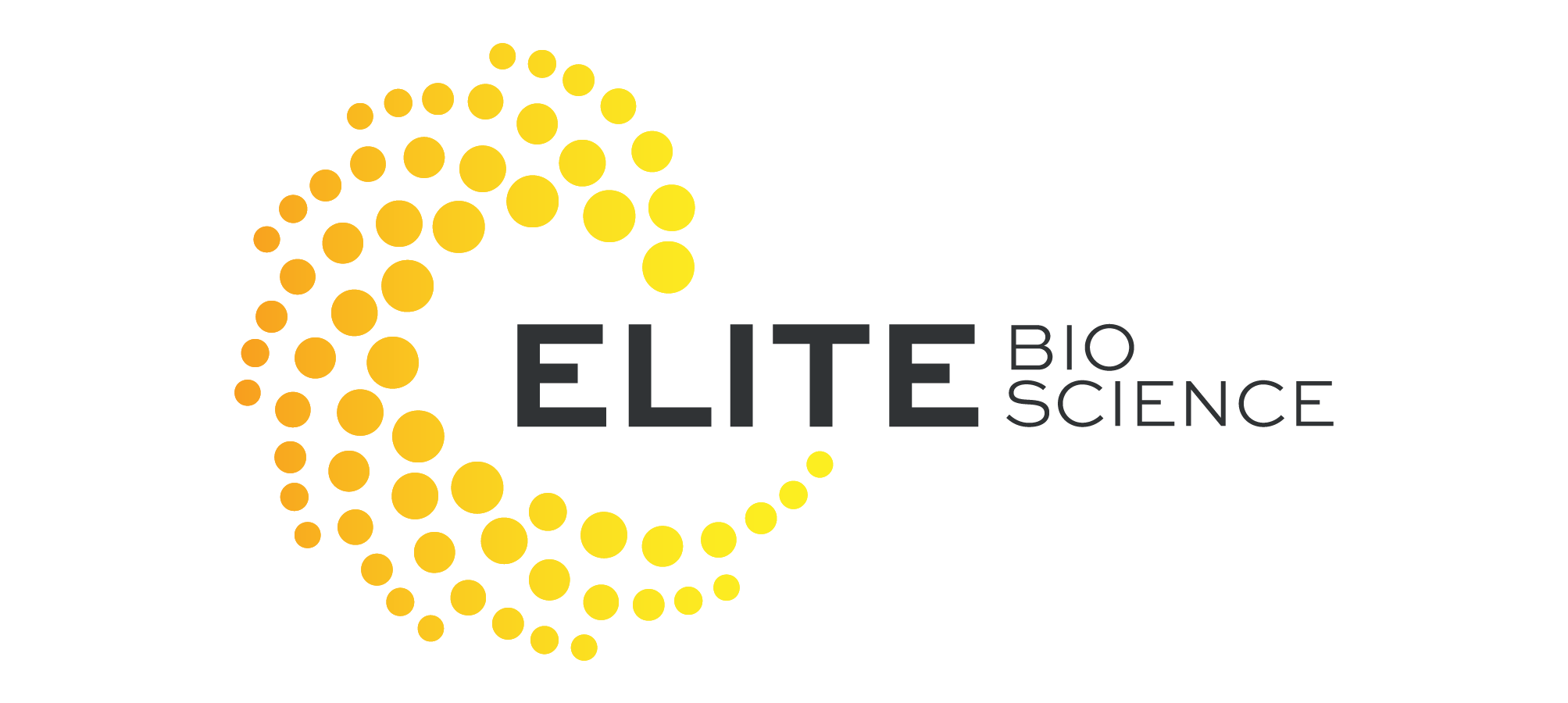What Are the Best Peptides for Muscle Growth? Top Picks & Benefits
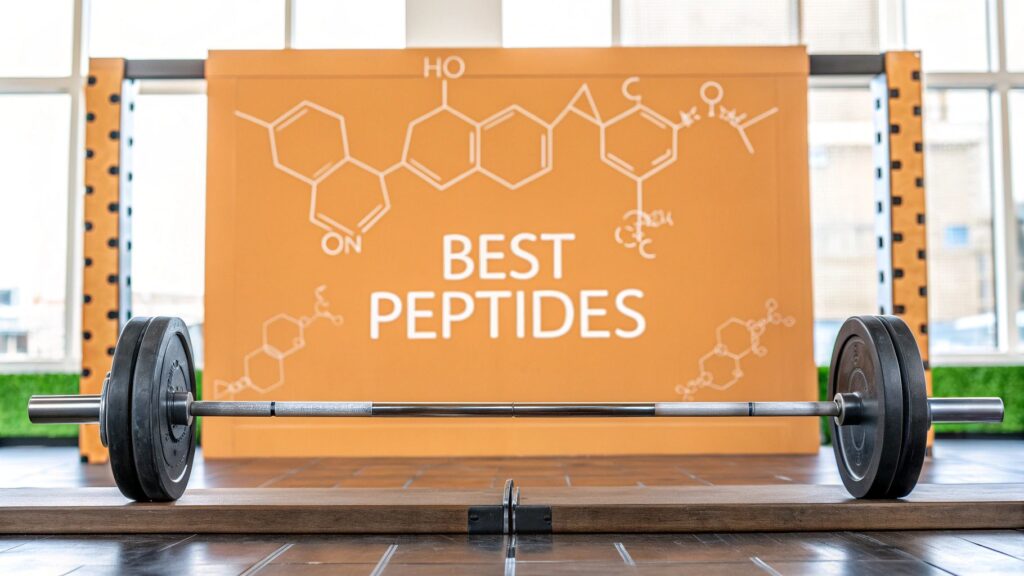
If you’ve ever felt stuck in a training rut, chances are you’ve heard people talking about peptides. But what are they, really? And how can they actually help you build more muscle?
Think of peptides as highly specific messengers—short chains of amino acids that deliver precise instructions to your cells. They aren’t a blunt instrument like anabolic steroids; they’re more like skilled negotiators. Instead of flooding your system with foreign hormones, they simply signal your own body to ramp up its natural processes.
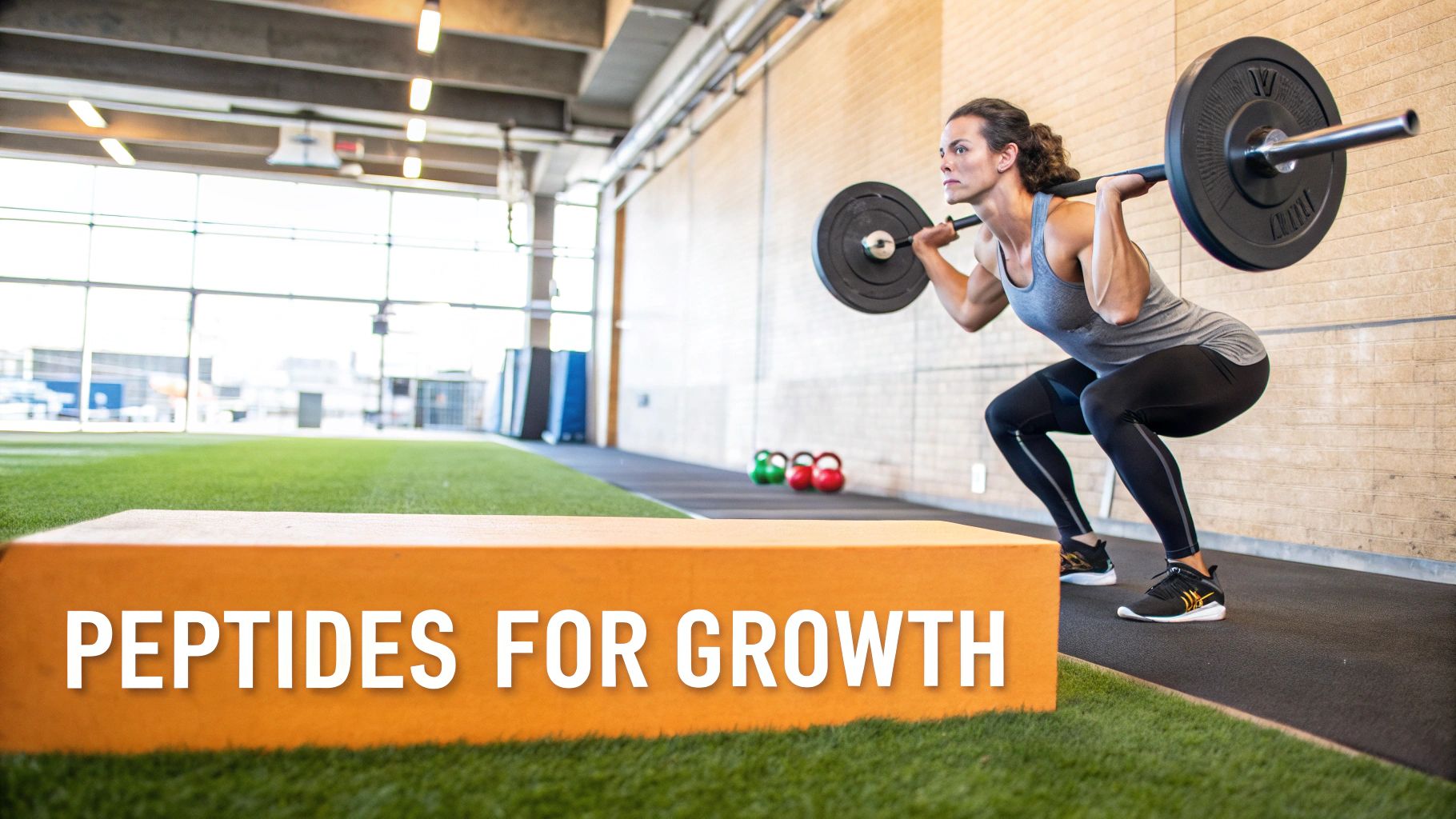
When it comes to building muscle, their main job is to gently nudge your pituitary gland to release more growth hormone (GH). This targeted approach is what sets peptides apart.
How Peptides Work With Your Body, Not Against It
This guide is here to cut through the noise and show you how these compounds can support your goals. We'll be focusing on the most effective options, exploring how they help by:
- Boosting Natural GH Production: Certain peptides known as GHRHs (Growth Hormone-Releasing Hormones) and GHRPs (Growth Hormone-Releasing Peptides) work in tandem, hitting different pathways to create a powerful, synergistic spike in your natural GH levels.
- Speeding Up Recovery: Compounds like BPC-157 are all about healing. They help repair damaged tissues faster, which means you can get back in the gym sooner and train harder.
- Improving Body Composition: More GH and its downstream partner, IGF-1, don't just help you build muscle. They also crank up your body's fat-burning machinery.
By understanding how to use these signaling molecules, you can create an internal environment that’s perfectly primed for muscle repair, recovery, and growth—all while working in harmony with your body’s own biology.
This refined method is what makes peptides such a compelling option for enhancing physique and performance. They optimize your natural pathways instead of overriding them.
To help you get started, here is a quick overview of the top peptides we'll be discussing.
Top Peptides for Muscle Growth At a Glance
This table summarizes the leading peptides for muscle development, highlighting how they work and their main benefit.
| Peptide | Primary Mechanism | Key Benefit for Muscle Growth |
|---|---|---|
| CJC-1295 DAC | A GHRH that provides a steady, long-lasting increase in GH levels. | Creates a consistent anabolic environment for sustained muscle growth. |
| Ipamorelin | A GHRP that stimulates a clean, targeted pulse of GH without unwanted side effects. | Promotes lean muscle gains and fat loss with minimal impact on cortisol. |
| Sermorelin | A GHRH that mimics the body's natural GH release patterns. | Supports overall anti-aging benefits alongside steady muscle development. |
| BPC-157 | An angiogenic peptide that accelerates tissue healing and reduces inflammation. | Drastically improves recovery time, allowing for more frequent and intense training. |
| TB-500 | A synthetic version of Thymosin Beta-4 that promotes cell migration and repair. | Enhances recovery, reduces soreness, and improves flexibility and joint health. |
Think of this as your roadmap. We’re about to break down the science, compare the key players, and give you the knowledge you need to understand how peptides can fit into your fitness journey safely and effectively.
How Peptides Signal Your Body to Build Muscle
To really get how peptides help you build muscle, you have to look past the weights and deep inside your body’s own signaling network. Think of peptides as highly specific messengers, like a key cut for a single, unique lock—in this case, a cellular receptor. When that peptide “key” turns its matching “lock,” it delivers a very precise command to the cell.
This targeted action is what sets peptides apart from other performance enhancers. Instead of flooding your system with a synthetic hormone that causes all sorts of broad changes, peptides work by influencing your body's own natural processes. They’re communicators, not sledgehammers. For muscle growth, their main job is to talk to the pituitary gland, the body's master controller for growth.
The GH and IGF-1 Axis Explained
The most important pathway for building muscle is the growth hormone (GH) and insulin-like growth factor 1 (IGF-1) axis. This natural chain reaction is what your body uses to repair tissue, burn fat, and, most importantly, build new muscle. In simple terms, your brain tells your pituitary gland to release GH, which then heads over to the liver and signals it to release IGF-1.
IGF-1 is the real MVP when it comes to hypertrophy. It directly fires up muscle protein synthesis—the process of patching up the micro-tears you create during a workout and rebuilding them bigger and stronger. Peptides designed for muscle growth are engineered to crank up this natural process right at the source.
There are two main classes of peptides that get this done, and they each work on a different part of the pituitary gland's control system.
- Growth Hormone-Releasing Hormones (GHRHs): Peptides like CJC-1295 are in this group. They mimic your body’s natural GHRH, gently telling the pituitary gland to produce and release more growth hormone over a longer period. Think of a GHRH as slowly turning up the volume on your body's GH production.
- Growth Hormone-Releasing Peptides (GHRPs): This class, which includes peptides like Ipamorelin, hits a different receptor (the ghrelin receptor). GHRPs trigger a strong, clean pulse of GH release. This is more like flipping a switch for an immediate burst of growth hormone.
By stimulating the body to produce its own growth hormone, peptides create an anabolic environment that is more aligned with natural physiological patterns. This makes them a more refined tool for optimizing muscle growth and recovery.
Synergistic Signaling for Maximum Effect
The real magic happens when you use these two types of peptides together. Combining a GHRH with a GHRP creates a synergistic effect that produces a much larger and more sustained release of GH than either could ever achieve on its own. It's like flooring the accelerator (the GHRP) while making sure the fuel line is wide open (the GHRH).
This one-two punch maximizes the natural GH pulse from the pituitary, leading to higher levels of both GH and, consequently, IGF-1 circulating in your system. This elevated anabolic state creates the perfect conditions for muscle fiber repair and growth, turning all your hard work in the gym into real, noticeable results.
This infographic breaks down the response times and effects of GHRHs versus GHRPs.
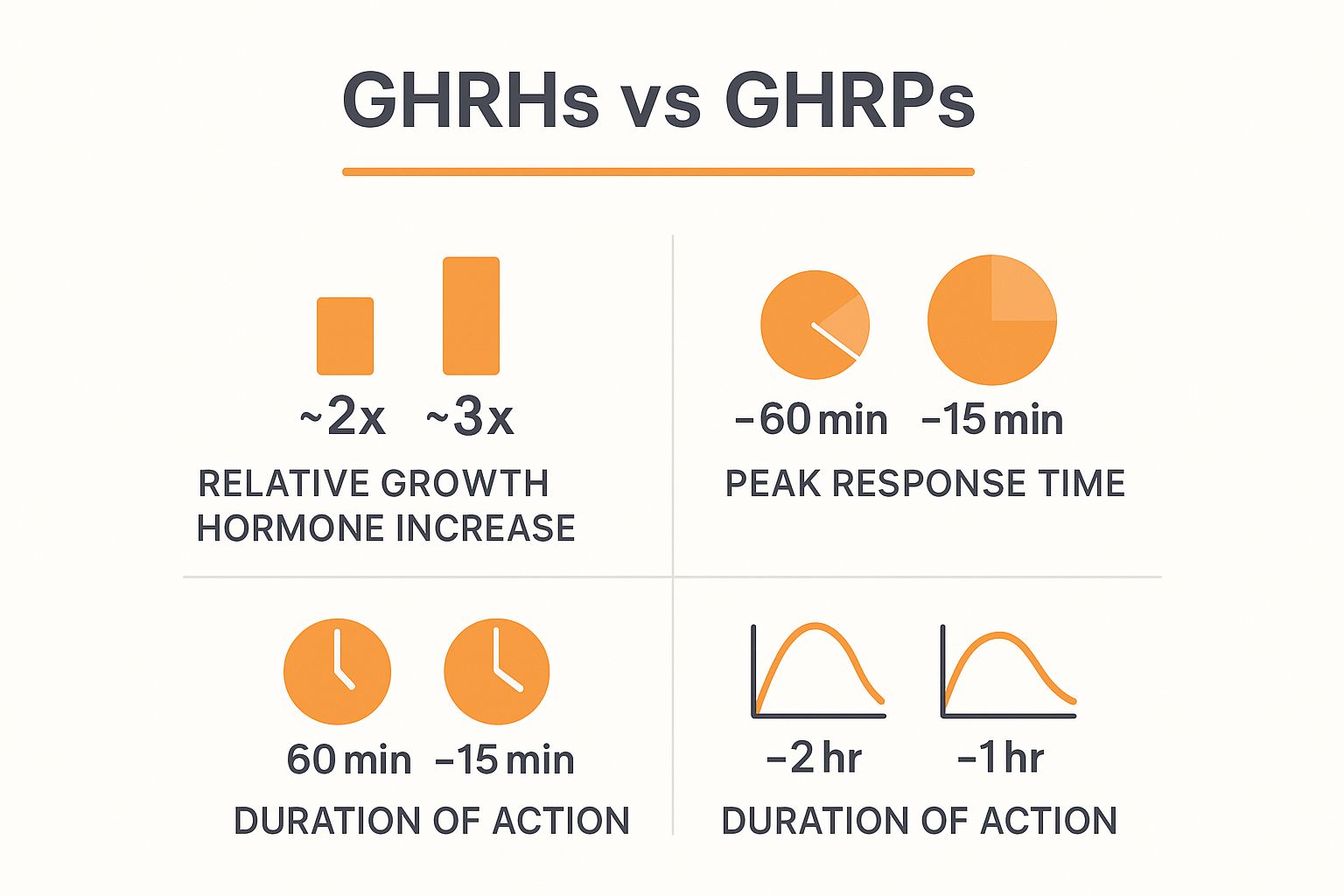
As you can see, GHRHs give you a longer, steadier effect, while GHRPs deliver a faster and more powerful initial spike in growth hormone. Understanding this dynamic is crucial for seeing why certain peptide stacks are recommended for anyone looking for the best peptides for muscle growth.
A Deep Dive into the Top Muscle-Building Peptides
Alright, now that we’ve covered the basics of how peptides send signals, let's get into the specifics. We're going to look at the actual compounds that get the job done for muscle growth. While there are a lot of options out there, a few really rise to the top because of how they work and, more importantly, how well they work together. These are the go-to choices for anyone asking, "what are the best peptides for muscle growth?"
We’ll focus on the heavy hitters in the growth hormone secretagogue family—CJC-1295, Ipamorelin, and Tesamorelin. Each brings something unique to the table, from long-lasting growth hormone release to shredding stubborn body fat, making them powerful tools for anyone serious about their physique.
CJC-1295: The Foundation for Sustained Growth
Think of CJC-1295 as the base layer for any serious muscle-building plan. It’s a synthetic version of Growth Hormone-Releasing Hormone (GHRH), which is the body's natural signal to produce more growth hormone. The key difference? Your body's GHRH has a very short fuse, lasting only minutes. CJC-1295 is built to last, staying active in your system for days.
This long-lasting action creates a stable, elevated level of growth hormone. Instead of getting brief, sharp spikes, you get a consistent anabolic environment that keeps your body in a state of repair and growth, 24/7. It’s the perfect foundation.
The real proof is in the numbers. Clinical studies on healthy young men showed that CJC-1295 can crank up plasma growth hormone levels by 2 to 10 times over six days. This, in turn, leads to a 1.5 to 3-fold increase in IGF-1 levels for up to 11 days—a direct signal for muscle protein synthesis and growth. You can dive deeper into these peptide findings and their implications for athletic performance.
Ipamorelin: The Precision GH Releaser
If CJC-1295 provides the steady, foundational signal, Ipamorelin delivers the clean, powerful pulse. Ipamorelin is a Growth Hormone-Releasing Peptide (GHRP) that works by mimicking ghrelin (the "hunger hormone") to trigger a strong, but very specific, release of GH from your pituitary gland.
What really sets Ipamorelin apart is its selectivity. It gives you a significant GH pulse without messing with other hormones like cortisol or prolactin. Since elevated cortisol is catabolic (meaning it breaks down muscle), avoiding it is a huge win for anyone focused on building muscle.
Ipamorelin is prized for its "clean" effect. It delivers a potent anabolic signal for muscle growth and fat loss while minimizing the risk of unwanted side effects like increased anxiety or water retention that can accompany less selective GHRPs.
This precision makes Ipamorelin the perfect partner for CJC-1295. The combination is a true one-two punch for maximizing your body's natural growth hormone production.
The Power of Stacking: CJC-1295 and Ipamorelin
Combining CJC-1295 with Ipamorelin is, without a doubt, the most popular and effective peptide stack for building muscle. When you use them together, you're hitting two different mechanisms at once, creating a synergistic effect that's far more powerful than what either could do on its own.
Here's a simple way to think about it:
- CJC-1295 (the GHRH) acts like a volume knob, turning up the pituitary gland’s capacity to produce and store growth hormone.
- Ipamorelin (the GHRP) then acts like a trigger, causing a massive, immediate release of all that stored GH.
This dual-action approach results in an amplified pulse of growth hormone that drives up circulating levels of IGF-1. For anyone looking to get the most out of their body’s anabolic potential, understanding the synergy between CJC-1295 and Ipamorelin is absolutely essential for seeing real results in muscle gain and body composition.
Tesamorelin: The Dual-Action Body Recomposition Agent
Tesamorelin is another powerful GHRH analog, but it comes with a game-changing bonus: targeted fat loss, especially visceral fat (the dangerous fat around your organs). It was originally created to treat HIV-associated lipodystrophy, but its incredible effects on body composition quickly made it a favorite among athletes.
Just like CJC-1295, Tesamorelin signals the pituitary to release more growth hormone. But its impact on fat metabolism is what makes it stand out. By elevating GH and IGF-1, it helps drive nutrients toward muscle cells for repair while simultaneously telling fat cells to release their stored energy.
This makes Tesamorelin a fantastic choice for a lean bulk or a body recomposition phase, where the goal is to pack on muscle while stripping away body fat at the same time.
Comparing Leading Growth Hormone Peptides
Choosing the right peptide really comes down to your specific goals. To make it easier, here’s a quick side-by-side look at the top contenders we’ve discussed.
| Peptide | Type (GHRH/GHRP) | Primary Benefit | Typical Half-Life |
|---|---|---|---|
| CJC-1295 DAC | GHRH | Sustained, long-lasting GH release for a consistent anabolic state. | ~8 days |
| Ipamorelin | GHRP | Clean, selective GH pulse without affecting cortisol or prolactin. | ~2 hours |
| Tesamorelin | GHRH | Potent GH release with significant visceral fat reduction. | ~25-40 minutes |
So, what's the verdict? If your primary goal is pure, sustained muscle growth, the CJC-1295 and Ipamorelin stack remains the gold standard. But if you’re looking to build muscle while aggressively targeting stubborn body fat, adding Tesamorelin to the mix could give you that extra edge. By understanding what makes each of these peptides unique, you can build a smart protocol that truly supports your training and physique goals.
The Unsung Heroes of Recovery and Repair
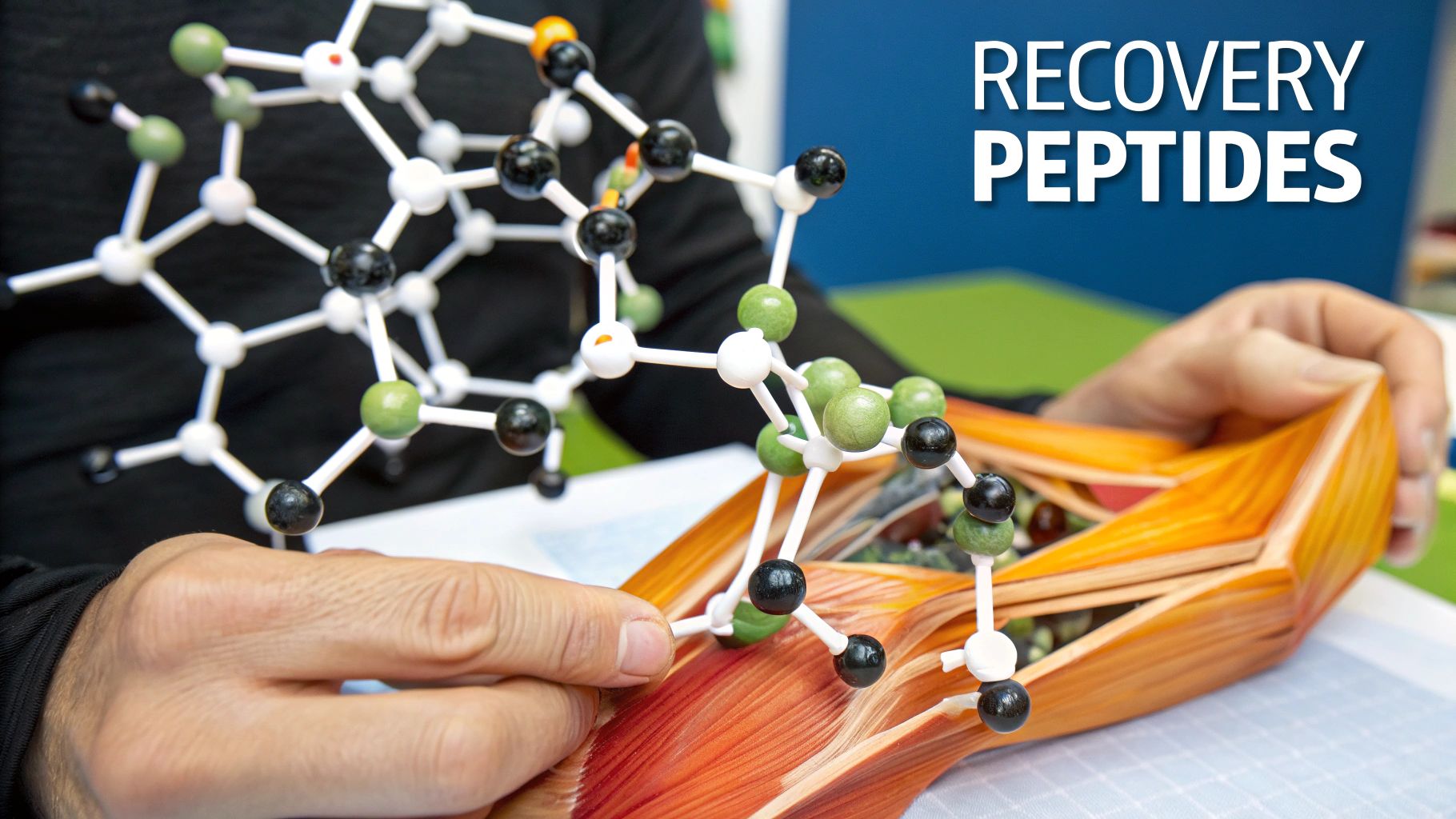
While the peptides that trigger growth hormone get all the glory, they only tell half the story of building a truly impressive physique. Intense training is just the stimulus. The real magic happens during recovery.
If your body can’t properly repair the damage you inflict in the gym, you’ll never come close to your full potential. It's that simple. This is where recovery and repair peptides step in.
Think of them as your body’s elite support crew, working behind the scenes to patch up micro-tears, squash inflammation, and reinforce the very tissues that support your muscles. Skipping this part of the equation is like building a skyscraper on a weak foundation—it’s just a matter of time before something gives.
BPC-157: The Targeted Repair Specialist
Imagine you could send a specialized repair team directly to the site of an injury. That's pretty much what BPC-157 does. Derived from a protective protein found in our own stomach acid, this peptide has a remarkable knack for accelerating healing right where you need it most.
It works by promoting angiogenesis, which is the creation of new blood vessels. This process is crucial because it delivers a fresh supply of oxygen and nutrients right to the damaged tissue. Whether it’s a nagging tendon, a strained ligament, or just beat-up muscle fibers, BPC-157 helps orchestrate a faster, more efficient healing response.
This translates to some serious real-world benefits:
- Reduced Downtime: You get back to training faster after those inevitable tweaks and strains.
- Stronger Connective Tissues: It helps fortify your tendons and ligaments, making them more resilient against future injury.
- Less Post-Workout Soreness: By calming inflammation, it helps you feel fresher for your next session.
By improving your ability to recover, BPC-157 lets you maintain greater training consistency and intensity—the undisputed cornerstones of long-term muscle growth.
TB-500: The Systemic Healing Agent
If BPC-157 is the local specialist fixing a specific problem, TB-500 is the general contractor overseeing a full-body renovation. As a synthetic version of a naturally occurring peptide called Thymosin Beta-4, TB-500 promotes systemic, or whole-body, repair.
Its effects aren't just limited to the injection site; it circulates throughout your system, going wherever it's needed. TB-500’s main job is to upregulate proteins like actin, a fundamental component of cell structure and movement. This encourages cells to migrate to sites of injury, speeding up the repair of muscle, tendons, and even skin.
For athletes and hard-training lifters, TB-500 is invaluable. It helps reduce inflammation, improve flexibility, and address those widespread aches and pains that come with the territory. It helps your entire system bounce back more effectively.
When used together, BPC-157 and TB-500 create a powerful synergistic effect. BPC-157 provides the targeted, localized healing while TB-500 supports the overall recovery environment. To get a deeper understanding of how these compounds support your body, check out our guide on peptides for healing and recovery.
Collagen Peptides: The Fundamental Building Block
Beyond the injectable research compounds, there's an incredibly effective and accessible tool for supporting your body's structural integrity: collagen peptides. As the most abundant protein in the human body, collagen is the literal glue that holds your connective tissues—tendons, ligaments, and fascia—together.
Supplementing with collagen gives your body the raw amino acids it needs to fortify these crucial structures. This is especially important for anyone pushing their limits with heavy weights, as strong muscles need an equally strong support system to function correctly.
And the benefits aren't just theoretical. A key study showed just how impactful this simple supplement can be. In a 12-week trial, young men who consumed 15g of collagen peptides daily alongside a resistance training program saw significantly greater increases in both body mass and fat-free mass compared to a placebo group. The collagen group also showed superior improvements in muscle strength and an upregulation of 221 muscle proteins linked to contractile fibers, compared to just 44 in the placebo group. You can learn more about how peptides contribute to muscle growth from this research.
Ultimately, a holistic approach is key. Focusing only on growth signals without supporting the underlying structures is a recipe for stalled progress and injury. Incorporating recovery agents like BPC-157, TB-500, and collagen peptides ensures your body can not only handle intense training but thrive on it, paving the way for sustainable, long-term gains.
Navigating Peptide Protocols Safely and Effectively
Knowing what different peptides can do is just the starting point. To actually see those benefits, you have to approach this process with a disciplined, safety-first mindset. This boils down to three critical pillars: sourcing, handling, and dosing. Get these right, and you’re set up for success without unnecessary risks.
Think of it as being the head chemist in your own experiment—precision and quality control are everything.
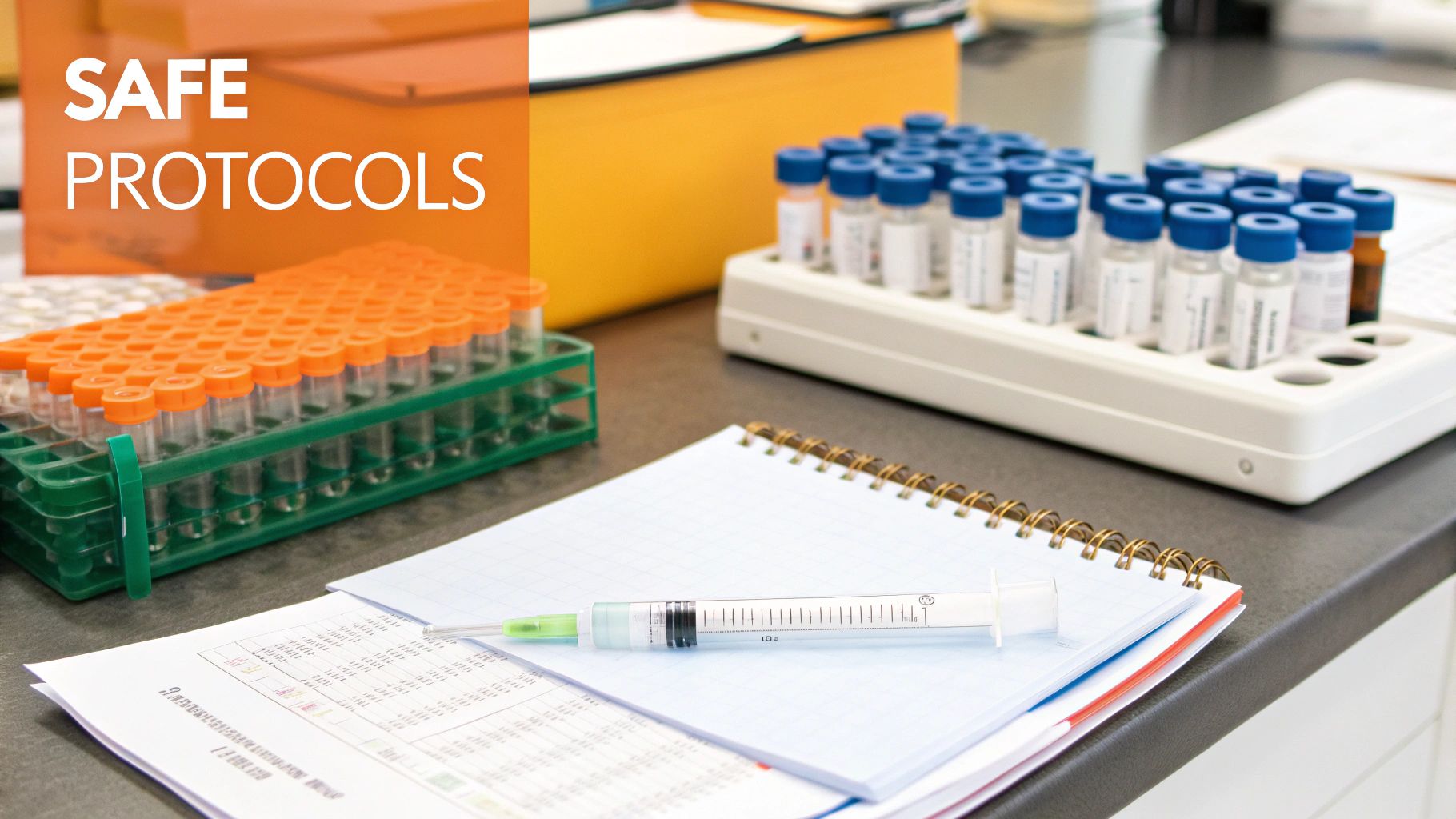
Your journey actually begins long before your first dose. It starts with where you get your peptides. The market is flooded with products of wildly different quality, and choosing a reputable supplier is non-negotiable. An unreliable source might send you something that's underdosed, contaminated, or not even the right substance at all.
This is why third-party purity testing is the absolute gold standard. Trustworthy labs like Elite Bioscience provide certificates of analysis that verify the identity, purity, and potency of their peptides. That transparency means you know exactly what you’re putting into your body.
Proper Handling and Reconstitution
Once you’ve got a high-quality product in hand, proper handling is essential to keep it that way. Most peptides for muscle growth arrive as a lyophilized (freeze-dried) powder in a sterile vial. To use them, you’ll need to reconstitute them with bacteriostatic water, a process that demands a bit of care.
Here’s a quick rundown of the steps:
- Preparation: Get your supplies ready—the peptide vial, bacteriostatic water, and an alcohol wipe. Give the tops of both vials a thorough cleaning with the wipe.
- Mixing: Gently inject the correct amount of bacteriostatic water into the peptide vial. Make sure to aim the stream against the side of the glass to avoid breaking down the delicate peptide chains.
- Dissolving: Never shake the vial. Instead, gently swirl or roll it between your hands until the powder is completely dissolved. Shaking it vigorously can literally destroy the peptide’s structure.
Storage is just as important. Once reconstituted, your peptides must be kept refrigerated to maintain their stability and effectiveness.
Core Dosing and Cycling Principles
With your peptide properly prepared, the next step is building a smart dosing protocol. A universal rule here is to start low and go slow. This lets you see how your body responds and helps you sidestep potential side effects like water retention or joint pain.
Cycling is another fundamental concept. Using a peptide continuously for a long time can cause your body's cellular receptors to become desensitized—think of it like tuning out a constant background noise. When that happens, the peptide just stops working as well.
To prevent this, peptides are typically run in cycles—for example, 8-12 weeks on, followed by a 4-week break. This rest period allows your receptors to reset, ensuring the peptide remains effective when you start back up.
A well-structured protocol is your key to maximizing results while putting your health first. For a more detailed breakdown of specific amounts and schedules, our comprehensive peptide dosage guide offers in-depth information to help you build a responsible plan.
Ultimately, navigating the world of peptides is a process of education and diligence. Sourcing from trusted labs, handling products with care, and sticking to smart dosing principles are the cornerstones of any safe and effective protocol. Always talk with a qualified healthcare professional before starting any new regimen to make sure it aligns with your health and goals. This responsible approach is the only way to find out what the best peptides for muscle growth can truly do for you.
Common Questions We Hear About Peptides
Stepping into the world of peptides can bring up a lot of questions. That’s perfectly normal. This is your guide to the most common queries we get, with straightforward answers to give you a clear picture of how these compounds work.
Are Peptides Safe and Legal?
This is probably the most important question, and the answer is nuanced. The legal landscape for many peptides is a bit of a gray area. Most are sold for research purposes only and haven't been approved by the FDA for you and me to use. This reality puts a massive spotlight on where you get them—your safety is directly tied to the purity and quality coming from the lab.
While they're generally seen as a safer alternative to anabolic steroids, they aren't completely without side effects. Things like water retention or a bit of joint pain can pop up. That's why it is absolutely essential to talk with a knowledgeable medical professional who can look at your specific health situation before you even consider starting.
How Quickly Will I Actually See Results?
When it comes to peptides, patience is your best friend. You'll likely feel some of the benefits pretty quickly, like better sleep or faster recovery after a tough workout, often within the first few weeks. But visible, measurable changes in muscle and body composition? That takes a bit more time.
For most guys, you're looking at a solid 8 to 12 weeks of consistent use before the mirror starts showing you significant results. Peptides are powerful tools, but they aren't magic pills. They work by amplifying the results of the hard work you’re already putting in at the gym and in the kitchen. If that foundation isn't solid, you won't get the outcome you're looking for.
Think of peptides as catalysts, not replacements for hard work. They accelerate the physiological processes that build muscle, but only when the right stimulus—proper diet and intense training—is consistently applied.
Is Stacking Different Peptides a Good Idea?
Yes, it absolutely can be. Stacking—or combining different peptides—is a common strategy used to create a powerful synergistic effect. It’s like having a team of specialists working together. By using peptides that target different biological pathways at the same time, you can achieve a result that’s much greater than what any single one could do on its own.
A classic stack is pairing a GHRH, like CJC-1295, with a GHRP, like Ipamorelin. Here’s how it works:
- CJC-1295 tells your pituitary gland to get more growth hormone ready for release.
- Ipamorelin then signals a strong, clean pulse to let all that stored growth hormone out.
This one-two punch creates a much bigger and more sustained release of GH than either compound could ever manage alone. Just keep in mind, this is a more advanced approach that requires careful planning around your dosing and cycling to manage side effects and get the most out of it.
How Are Peptides Different from Anabolic Steroids?
The fundamental difference really comes down to precision versus brute force. Anabolic steroids are synthetic hormones that essentially hijack your system, binding to androgen receptors to force muscle growth. This direct, overwhelming approach often leads to significant hormonal shutdown and a laundry list of potential side effects.
Peptides, on the other hand, are much more like skilled negotiators. They are signaling molecules that gently encourage your body’s own systems—like the pituitary gland—to ramp up its natural production of growth hormone. This targeted, upstream action generally comes with a much more favorable safety profile because it works with your body’s physiology instead of completely overriding it.
At Elite Bioscience, we provide access to high-quality, third-party tested therapies to support your health and performance goals. Explore our tailored peptide and hormone treatments designed for safety and effectiveness.
QUICK SEARCH
Make an account today to start your journey towards a better and healthier lifestyle.
